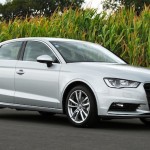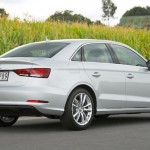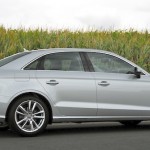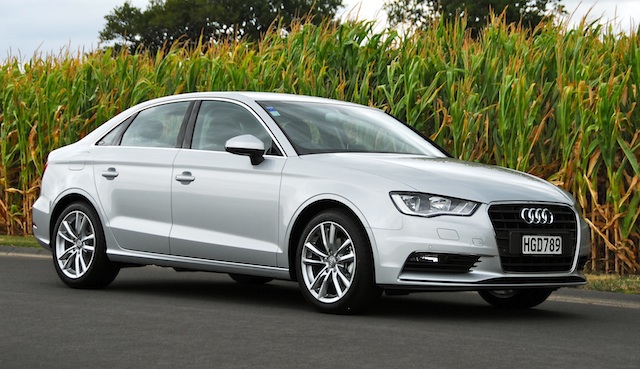
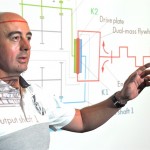
Unlike many other global markets, demand for small sedans in New Zealand is weak, a fact not lost on Audi general manager Dean Sheed.
But he reckons he’s found a gap in the NZ market for his latest arrival, the A3 sedan. That raises the question: Is there a market in the gap?
“I believe there is,” he said. “It is a niche market, certainly, but it is big enough to be exploited. For example, many immigrants coming into New Zealand prefer small sedans over small hatchbacks. The Chinese do.”
Small is the new big. Small cars accounted for 19 per cent of the 113,177 new vehicles sold in New Zealand last year; light (smaller again) cars represented 13 per cent. Combined, that’s 32 per cent. Most of that 32 per cent were hatchbacks. New Zealanders like them; small sedans less so.
But Sheed says forecasted sales growth of around 4 per cent in 2014 gives him wiggle room for the A3 sedan, the latest member of the A3 family, after the hatchback and the five-door Sportback, and the first A3 four-door. Sheed says he has looked long and hard at changing trends.
It was only a few years ago that SUVs had 15 per cent of the market – last year they occupied 27 per cent. In 2013 New Zealanders bought more SUVs than anything else. Carmakers are lining up to build them: large, medium, small and smaller, all with cleaner, more fuel-efficient, smaller capacity engines.
“You are seeing these days not only the downsizing of engines but of cars as well,” said Sheed. “We aim to grow the segment for small sedans. There is room for growth; not a lot, but enough to gain traction. The A3 sedan can become an entry point for the (medium) A4 sedan.”
Growth in all segments is part of Audi’s aim to sell two million vehicles worldwide by 2020. To do so it will boost its range from 49 to 60 different models, along the way helping its Volkswagen Group parent to become the No. 1 carmaker. That’s the goal anyway. The VW Group will invest 84 billion euros over the next five years in an attempt to unseat Toyota.
Last year in New Zealand, Audi sold 1820 vehicles, growth of 18 per cent over 2012. This year it is aiming for between 1900 and 2000 units. Much of this growth will centre around the smaller A3 and Q3 range, although it’s worth noting that Audi NZ last year sold more vehicles priced above $100,000 than either Mercedes-Benz, BMW, and Lexus. For example, it sold 10 RS6 Avant wagons in December alone and expects to move 40 this year. The RS6 Avant costs $198,000.
The A3 sedan is available with the choice of two engines: a 1.8-litre turbocharged four-cylinder petrol unit delivering 132kW/250Nm to the front wheels via a seven-speed automatic transmission; and a 2.0-litre boosted diesel four-pot producing 110kW/320Nm to the front wheels via a six-speed automatic.
Audi claims town-and-around fuel use for the petrol unit of 5.6 litres/100km (50mpg) for a C02 rating of 129gr/km; and 4.1 litres/100km (69mpg) for the 2.0-litre boosted diesel (107gr/km).
Both petrol and diesel cars are priced at $62,000. Why, when diesel has traditionally being a few grand more expensive? “We want to let the consumer decide on which car they want,” said Sheed.
The sedan uses the same MQB platform as the five-door Sportback (and a handful of others in the VW Group stable, including the Golf GTi). The result is slightly more rear legroom than the Sportback , although it is hardly generous, and 45 litres more room in the boot.
The exterior design is classy with trademark Audi cues, ingredients which make the A3 sedan every bit the junior executive. Same on the inside where the fit and finish of the minimalist layout and access to controls is as good as it gets. Seats are fabric, although leather is an option.
Standard kit is extensive; so is the list of options (including 18 and 19 inch wheels and lower suspension) topped off with a custom S line package for $5000. So what’s the A3 sedan like to drive?
A return run from Auckland through Waikato back roads showed up a pretty tidy package. The front and rear tracks are 20mm wider than the A3 Sportback and the standard sports suspension – MacPherson strut front and multilink rear – offered a fuss-free ride and handling mix.
The helm of the 1.8-litre model was quicker and more accurate than that of the diesel. The petrol car seemed to ride slightly softer than the diesel, too. No obvious explanation because both cars shared suspension settings and tyres. Just one of those things.
Those who want a more dynamic A3 performer with four doors will have to wait until May when the S3 quattro sedan turns up. It will be powered by a turbocharged 2.0-litre petrol engine delivering 221kW/380Nm. Audi says it will sprint from zero 100km/h in under five seconds.

